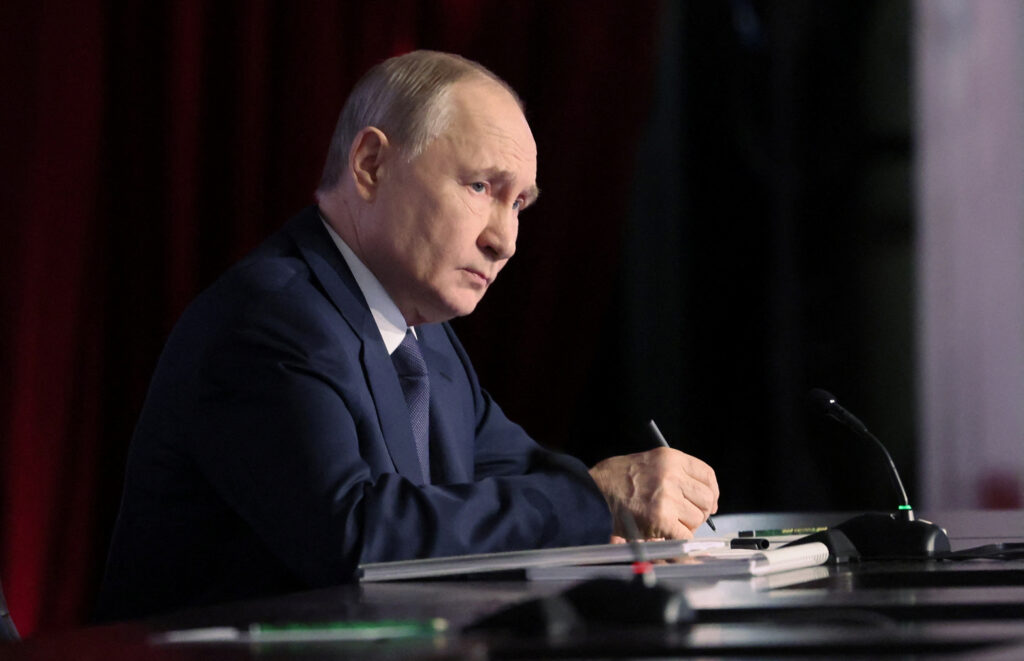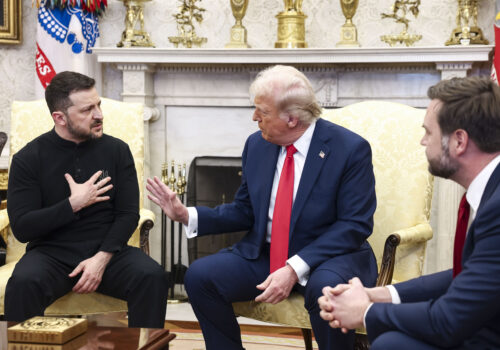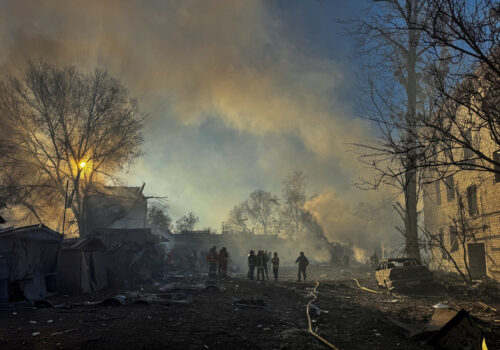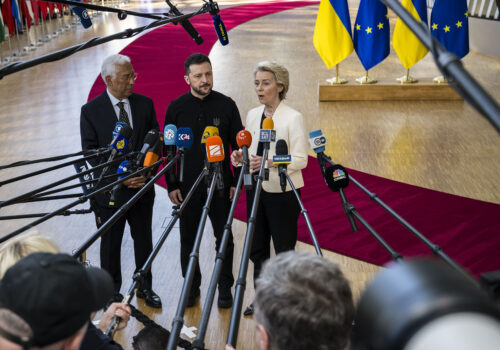Bernard M. Baruch, the American financier and statesman, famously said in 1946, “Every man has the right to an opinion, but no man has a right to be wrong in his facts.”
Trump administration officials will better achieve a just and lasting end to Russia’s unprovoked, illegal, and murderous (all facts) war in Ukraine if they first agree on what motivated Russian President Vladimir Putin to act. It was a revanchist desire to regain a lost empire that begins but doesn’t end with Ukraine. For Putin, any agreement he signs must serve that purpose.
Second, Trump administration officials need to be clear on what Putin is trying to achieve beyond that, beginning with the subjugation of other countries that once belonged to the Soviet bloc, including current members of NATO.
Putin is determined, working in a “no limits” partnership with Beijing, to roll back US global influence and replace it with a world order of Russia and China’s own making. Putin has said so plainly, as has Chinese President Xi Jinping, who has remarked to the Russian leader, “Now there are changes that haven’t happened in a hundred years. When we are together, we drive these changes.”
Peace through strength
With that as context, the best war-ending formula publicly available, one that begins with a deep understanding of those immutable facts, was published in Foreign Affairs this past Friday as “A Plan for Peace Through Strength in Ukraine.” Its authors are consistently wise voices on the United States’ role in the world: Stephen Hadley, a former US national security advisor; Daniel Fried, a former US ambassador to Poland; and Franklin D. Kramer, a former senior Pentagon official.*
The essay’s two most crucial paragraphs suggest a course correction in the Trump administration’s current approach, one involving both Europe and the possibility of NATO membership for Ukraine. This shift is necessary, the authors argue, if the president wants to avoid the fate of “the Biden administration’s disastrous withdrawal from Afghanistan.”
President Donald Trump was factually correct in his recent address to Congress in saying that then President Joe Biden’s botched withdrawal from Afghanistan in 2021 demonstrated weakness, which then encouraged Putin to launch his full-scale invasion of Ukraine in early 2022. One can draw a clear line. Building on that lesson, the authors argue that Trump accepting Russia’s “apparent terms for ending the war” risks demonstrating a similar weakness with similar outcomes.
“The best path to end the war will instead follow a ‘peace through strength’ approach,” write the authors. “Such an approach would substantially enhance Europe’s role in supporting Ukraine militarily and economically, with a limited but important backup role for the United States; accept the current lines of control between Russian and Ukrainian forces, without recognizing Russian annexation or sovereignty over Russian-occupied areas; and prepare the path for a negotiated settlement—all while considering, in the likely event that negotiations fail, how to achieve a cease-fire through unilateral action.”
Those last few words regarding the potential need for unilateral action are significant, as Putin is unlikely to accept any deal that would ensure outcomes that would serve Ukrainian, US, and allied interests.
So, it’s not too early for Trump administration officials to conjure a robust war-ending option absent Russia’s agreement, if Trump wants his place in history to be that of a global hero, worthy of a Nobel Peace Prize. The alternative is to risk falling into the trap of emboldening Putin, à la Biden.
“To pave this path,” the authors write, “Ukraine, Europe, and the United States must focus on four priorities: strengthening Ukraine militarily, applying additional economic pressure on Russia (but relaxing sanctions if it complies with an agreement), addressing Ukrainian security and economic needs through EU membership, and deterring Russia by granting Ukraine NATO membership.”
Nothing in the Foreign Affairs essay is more controversial or necessary than the deterrence value of offering Ukraine NATO membership if the country’s lasting security can’t be guaranteed through a ceasefire and peace agreement—or if Russia breaks an agreement that it signs, which it has a habit of doing.
The authors don’t mention that US Secretary of Defense Pete Hegseth seemed to take Ukraine’s NATO membership off the table on February 12. It’s unclear whether US negotiators have yet done the same. If so, they should put NATO membership back into the mix, both because history has shown it is the region’s most effective security guarantee and because it provides Trump with powerful leverage.
The author of Trump: The Art of the Deal recently lectured Ukrainian President Volodymyr Zelenskyy in the Oval Office that he was playing weak cards. No one understands better than Trump how foolish it would be to throw away your best cards at the beginning of a negotiation.
The Foreign Affairs authors are arguing that it is only the prospect of Alliance membership, should Putin continue to threaten Ukraine or not live by any agreement’s requirements, that would compel him to comply with peace terms. Finnish President Alexander Stubb has made a similar argument.
Write the authors: “A negotiating position based on these four priorities”—Ukraine’s military strength, economic pressure on Moscow, EU membership for Ukraine, and the deterrence value of NATO membership—“will give Ukrainians the confidence to negotiate and Putin the incentive to make negotiations successful.”
Beyond that, they write, to reach an agreement, “U.S. negotiators will have to avoid falling into a Russian trap that focuses first on improving U.S.-Russian relations while deferring the issue of Ukraine so that Russian forces have more time to take more Ukrainian territory.”
The hard truth about hard power
It’s worth considering other facts as US negotiators proceed.
There is a false notion that NATO provoked Russian intervention in Georgia in 2008 and Ukraine in 2014 by agreeing in Bucharest in 2008 that both countries would someday become Alliance members.
Hadley was on the ground in Bucharest negotiating the agreement on behalf of the Bush administration with recalcitrant German and French officials, who balked at giving those countries firmer and faster guarantees. It was that mushy middle ground that doomed them.
Want proof? Look at the former Soviet bloc countries that did become NATO members after the Cold War. They have remained stable and secure ever since, and they will do so as long as Russia believes that the United States and its NATO allies stand by their “all for one and one for all” security guarantee under the North Atlantic Treaty’s Article 5.
Under the headline “The real reason Russia invaded Ukraine (hint: it’s not NATO expansion),” the Atlantic Council’s Andrew A. Michta writes that much of the public debate about the war in Ukraine “seems increasingly disconnected from reality. The responsibility for the invasion and the carnage is unequivocally Russian President Vladimir Putin’s, and this simple fact ought to be the departure point for any rational path to ending the conflict.”
Michta argues, “The West is responsible not because it sought to redefine the security architecture of Europe’s historical crush zone in a way that favors its interests and the region’s stability and security, but rather because it failed to take the second fundamental step: the West failed to back up the new security architecture with hard power.”
Unlike in the aftermath of World War II, Michta writes, when the United States brought massive amounts of power to stabilize and rebuild Europe and deter any attempts at Soviet aggression against the free world, “the post-Cold War settlement was accompanied by a bewildering degree of disarmament across the collective West.”
Michta worries about a Ukraine deal that not only confirms Russia’s territorial gains, possibly allowing it to absorb the country over time, but also frees Russia to seek further gains, regionally and elsewhere, in its increasingly close partnership with China.
“Add to this the strategic myopia of key European politicians who, instead of recognizing what their weakness has wrought, speak instead about ‘being abandoned by America,’ and you have the perfect storm brewing just over the horizon,” writes Michta.
Michta usefully reminds readers that deterrence requires both military capabilities and the willingness to use them. “If you have neither,” he writes, “the correct term is ‘appeasement,’ with all that this is likely to entail down the line.”
Put most simply, the Trump administration’s negotiations with Russia will either deter or appease Putin’s well-telegraphed ambitions. The peace plan outlined in Foreign Affairs is a good place to start if Trump wants to avoid appeasement.
Frederick Kempe is president and chief executive officer of the Atlantic Council. You can follow him on X: @FredKempe.
This edition is part of Frederick Kempe’s Inflection Points newsletter, a column of dispatches from a world in transition. To receive this newsletter throughout the week, sign up here.
Note: Stephen Hadley is an executive vice chair of the Atlantic Council board of directors, Daniel Fried the Council’s Weiser family distinguished fellow, and Franklin D. Kramer a board member.
Further reading
Sun, Mar 2, 2025
Zelenskyy and Europe confront the first contours of the Trump World Order
Inflection Points By Frederick Kempe
The Ukrainian president’s tempestuous recent meeting at the White House was a window into a larger transformation of global order by the US president.
Fri, Mar 7, 2025
Former US Senator Rob Portman: How to achieve a successful cease-fire and lasting peace in Ukraine
New Atlanticist By
“We should all want the war on Ukraine to end, and we should welcome negotiations. But we should negotiate from a position of strength,” writes a former US senator.
Thu, Mar 6, 2025
How European leaders are responding to Trump’s approach to Ukraine and Europe
New Atlanticist By
From London and Berlin to Paris and Brussels, European leaders have taken several notable steps this week on security. This follows the blow-up between the Ukrainian and US presidents on February 28.
Image: Russia's President Vladimir Putin attends an extended meeting of the Interior Ministry board in Moscow, Russia, March 5, 2025. Sputnik/Mikhail Metzel/Pool via REUTERS



